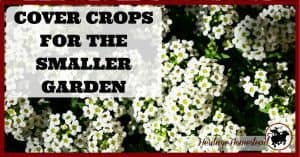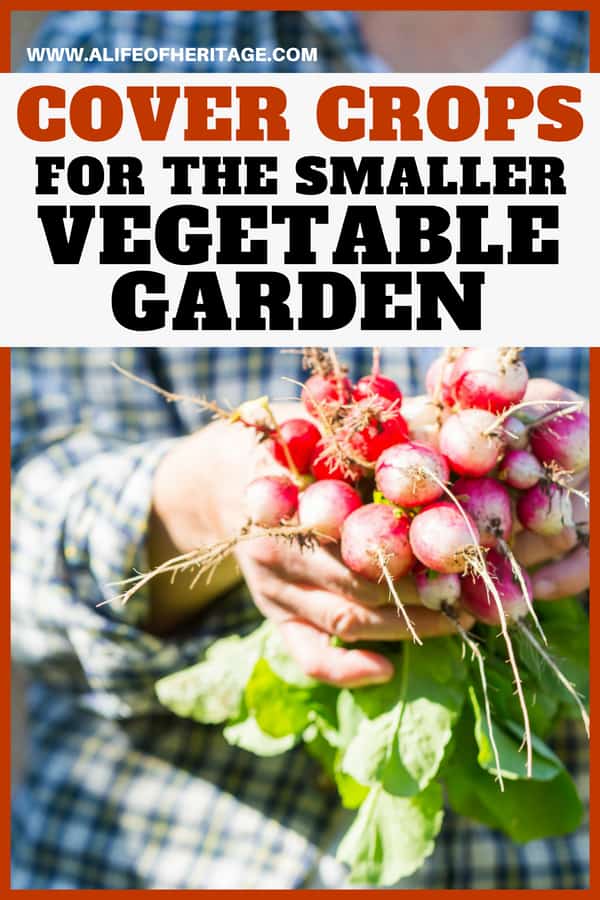Cover crops are underutilized and misunderstood in the smaller vegetable garden. Understand what they are, which to choose, and how to use them. Find more gardening articles on our Gardening Tips resource page.
I had a cover crop alright. A cover crop of charlie horse, that awful stinkweed, and a sticky, scratchy viney…weed thing…of some sort.
Oh, and grass. Grass, who’s roots weaved in and out and under every last bean, corn, and pea I had planted. That grass just knew that if I pulled them, it would pull up my plants too.
It was as if it were saying, “I dare you.”

The ground we walk on wants…no, NEEDS…to be covered with something green. And it will do whatever it takes to cover its nakedness.
Our earth is not only beautiful but modest. Nakedness is not its desired outcome.
So where there is naked ground, the earth covers it. Usually, first with weeds. Weeds are the saving grace of our planet. Don’t believe me? Read Why Does My Garden Have Weeds? It may be a surprise that weeds have a very significant purpose and they tell the important story of a garden.
And did you know that when a garden is tilled, it is utterly EXPOSED? Tilling is going against everything that nature intends. Learn how and why to do a no-till garden, it’s the first step to healthy soil.
So what is the best way to cover the nakedness of a garden?
Cover crops!
And even your small vegetable garden can utilize this important tool.
There are so many cover crop benefits that even the smallest of gardens shouldn’t miss out on them.
The first place to start is to look at nature. Undisturbed nature is a beautiful mastery of an assortment of all kinds of vegetation, all nestled right up to each other.
And this is why companion planting is the best way to plant a garden.
I grew up thinking that gardens had to be planted in neat, and slightly straight rows. (The slightly straight was made possible by the orange twine pulled tight between two dilapidated sticks.)
But actually, gardens should be messy!
A beautiful mess.
Now, where there isn’t mulch, use a cover crop. (Here is a great article on how and why to mulch.)
Here are some examples of cover crops for gardens.
You can download the PDF below:
(The download can be found in my resource library that over 5000 people have access to. It’s worth looking into, you can sign up below. 🙂 )
DON’T MISS OUT: FREE RESOURCE PAGE
Don’t head away just yet, continue reading below to learn about what a cover crop is and how to know which ones to choose.
There are quite a few cover crop examples in the list above that would be perfect in your garden, right?
It is worth taking the time to understand the advantages of planting a cover crop.
But first, by definition, what is a cover crop?
A crop planted primarily to manage:
• water
• weeds
• pests
• diseases
It is a way of planting that has been forgotten. And definitely not understood.
When it is utilized, it enriches the soil and provides protection against the elements, and provides food for the all-important microorganisms in the soil.
And those benefits, my friends, can’t be beaten.
So which cover crop should be chosen and why?
To start, three things must be identified:
1 – What are the goals and desired outcome?
• Control weeds?
• Supply nitrogen?
• Choose a cover crop that will meet specific needs and the desired outcome.
2 – What is the specific planting window?
• When will the cover crop be planted?
• Will it and when will it be terminated?
• Different crops planted at different times of the year will provide different functions to the soil. For instance, early spring planting will help control weeds. A fall planting will hold the soil in place during the winter and will provide great mulch in the spring.
• Knowing the goals for a location will help in the decision of when to plant the cover crop.
3 – What is the location?
• It is important to know and understand which crops do well in the area. Some don’t grow well in certain places or during certain times of the year. For instance, sweet clover is sown in the fall in the southeastern United States but in the spring in other parts of the country.
For the smaller garden, here are some examples of a few cover crops that may be the winning ticket to a modest garden. 😉
A radish cover crop is a great choice for many reasons. Planting radishes will:
• Retain soil moisture
• Reduce erosion
• Reduce soil compaction
• Add organic material to the soil
• Root channels allow for the soil to dry out and warm up faster in the spring
• Reseeds if allowed
A radish cover crop is probably the most popular but any root crop will have the same effect including beets, carrots, turnips, and kohlrabi.
And the benefits of a sweet alyssum cover crop:
• Dense ground cover
• Beautiful little flowers to attract insects
• Subtle, sweet scent
• Reseeds
Even the beautiful nasturtium and borage have more benefits than just being a beautiful flower, (that’s edible!). They provide a cover and attract those bees as well! Utilized as companions to certain vegetables, they can also deter or trap pests as well.
When in the midst of garden planning, it is more than acceptable to try out different types of cover crops to see which works best in each situation. An assortment of any or all of the vegetables and plants listed in the download above will fill a garden with an array of beauty, edibles, and purpose.
The soil will be enriched, the beneficial insects will come, and the weeds will be suppressed.
You know? I’m a redhead and if I’m honest, I find great delight in saying, “I dare you more” right back at the weeds and grass who have the nerve to take root in the healthy, mulched garden beds I’ve prepared for my vegetables.
Because of my cover crops, I dare you weeds. I dare you.

Continue reading about cover crops: